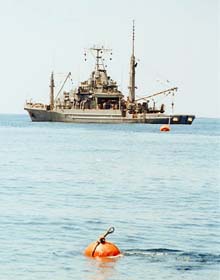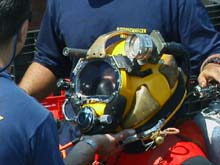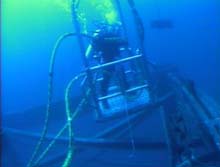
USS Grapple moored over the Monitor (the “wake” behind the buoy is actually caused by a strong Gulf Stream current pulling against the buoy, which is firmly attached to a mooring anchor on the seabed). (U.S. Navy photo). Click image for larger view.

Navy diver being “hatted up” for a dive to the Monitor. Note the camera and light mounted on the sides of the diver's helmet, allowing topside supervisors to see what the diver is seeing. (U.S. Navy photo). Click image for larger view.
Navy diver preparing to leave the diving stage, which is suspended over the top of the engine recovery structure (ERS) at a depth of nearly 200 feet. A large steel basket, containing hydraulic rams to be installed on the ERS, can be seen in the background, to the right of the dive stage. (US Navy photo). Click image for larger view.
Final Report - U.S. Navy Phase I
May 6, 2001John Broadwater, Manager
Monitor National Marine Sanctuary
Jeff Johnston, Historian
Monitor National Marine Sanctuary
CDR Barbara Scholley, Commanding Officer
Mobile Diving and Salvage Unit Two, U.S. Navy
The U.S. Navy salvage ship USS Grapple departed the Naval Amphibious Base in Little Creek, VA, on Saturday, April 21. On April 23, the ship was positioned directly over the Monitor and established a 4-point mooring. The Grapple’s primary goal was to install additional lifting equipment and position the engine lifting frame (ELF) directly over the Monitor’s engine in preparation for the June-July engine recovery expedition (Phase II). One dive was completed before severe weather conditions called a halt to all operations. High winds and storms caused one of the anchors to drag 200 yards along the seabed. The Grapple left the mooring and anchored 500 yards from the wreck to wait out the weather. The vessel was battered by high winds and heavy seas for several days before being able to get back into the moor.
Diving finally resumed on Saturday, April 28. With excellent sea conditions, Navy divers began the arduous task of installing heavy hydraulic rams, chains, and cables that are required for raising the Monitor’s engine. By May 3, the divers had completed most of their installation tasks; two of the four hydraulic rams had been installed. At that point,
however, divers noticed that a white film was forming on several metal blocks that made up part of the ram assemblies. Further investigation confirmed that aluminum blocks had inadvertently been installed on the steel ram assemblies. When aluminum and steel are placed in salt water, they develop an electrical potential that results in rapid corrosion of the aluminum components. Therefore, with no way to replace the aluminum parts underwater, the rams had to be retrieved for repair on shore.The rams were recovered on May 4. The long-range weather reports indicated that only two more days of diving would be possible before conditions deteriorated severely. May 5 and 6 were spent removing and replacing the lifting chains between the spreader and the ELF. One new chain was installed and another was removed before the Grapple had to depart the Sanctuary and return to Little Creek.
In all, a total of 32 dives were conducted, logging more than 30 hours of bottom time. In spite of the setback due to the faulty ram components, some very useful work was accomplished. Procedures were developed and proved for moving equipment in the lift basket and attaching it to the spreader and lifting frame. The divers replaced lifting chains, installed chain stoppers (restraints), and thoroughly inspected the lifting structure. Also, they were able to develop an efficient method of deploying and installing the rams, so that the job should go quickly in June. Another major objective was training, and divers from the USS Grapple obtained some valuable experience working in the dynamic environment at Hatteras.
While the Grapple was conducting on-site dives, The Mariners' Museum was continuing its preparations for engine recovery. Museum officials are working with the U.S. Army Transportation Headquarters, Ft. Eustis, VA, and Newport News Shipbuilding to coordinate the complicated procedures for delivering the engine to Museum for conservation. The huge tank required for the engine conservation treatment--35 x 35 feet square and 10 feet high--is in place and ready.
Planning continued at all levels, with task groups meeting weekly to review and coordinate the myriad tasks required for the expedition, including engineering, logistics, diving systems, procurement, and funding. The overall planning team also met weekly to review task group reports and to identify priorities and action items. By the time the Grapple returned to port, many of the key elements were coming together and the team shifted all its efforts toward mobilizing the barge that will support Phase II recovery operations.
Sign up for the Ocean Explorer E-mail Update List.























